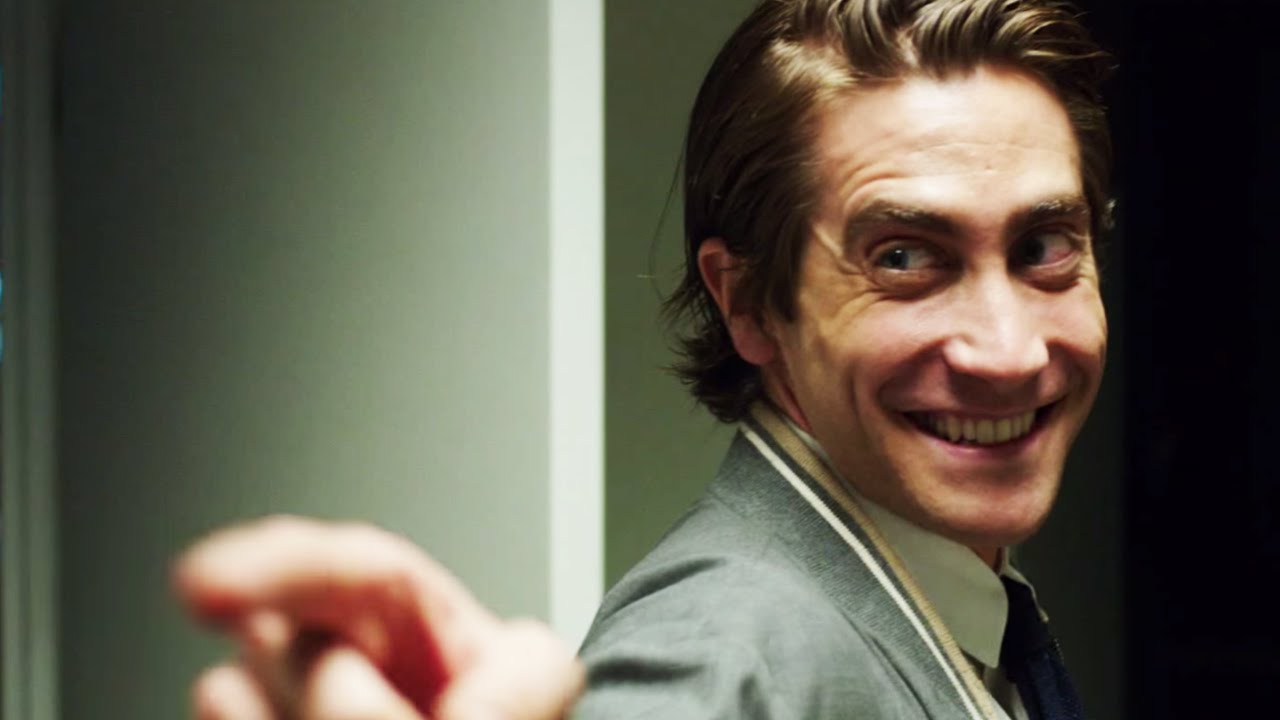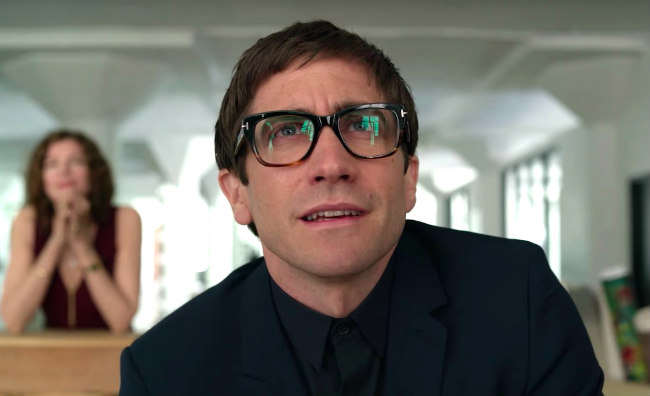By now, you’ve surely witnessed the majesty of John Mulaney’s latest musical sketch on Saturday Night Live.
“Airport Sushi” tells the harrowing tale of a clueless traveler (Pete Davidson) who unknowingly commits a heinous crime: ordering packaged sushi from a convenience shop in a LaGuardia terminal. It’s become something of a tradition when the comedian returns to his old stomping grounds on hosting duties, these show tunes repurposed around universal experiences — ordering lobster at a late-night diner, using a bodega bathroom, bravely sampling uncooked fish in Newark — but this most recent skit welcomed a surprise guest… Jake Gyllenhaal.
To be more precise, a disheveled, pajama-clad Jake Gyllenhaal who gave fans a stirring performance as a man who enjoys being patted down by TSA agents. Set to the tune of Wicked’s “Defying Gravity,” Gyllenhaal was hoisted towards the rafters after his crooning invitations to airport security workers begging them to “search his cavity” gave audiences a good laugh, and maybe, a confusing aftertaste.
“When did Jake Gyllenhaal get weird?” is how one friend put it when I shared the video in a group text.
(To be fair, the last Gyllenhaal feature that this friend could remember was Prince of Persia, so, process that shameful admission of guilt how you will.) But it sparked an even more puzzling question than the one surrounding edible airport food that would soon follow, one I simply can’t let go of.
Are there people out there who don’t know that Jake Gyllenhaal is, in fact, weird?
Sure, he’s only recently begun to cultivate a level of quirkiness that includes musical interludes on Netflix specials and memeable press tour moments for superhero franchises, but it’s been a long and winding road to Jake Gyllenhaal becoming John Mulaney’s manic pixie dream girl, and we’ve got the receipts to prove it.

In The Beginning …
There was a cherub-faced, wide-eyed Gyllenhaal scoring his first starring role at the age of 17 in a feel-good drama, October Sky. Gyllenhaal played Homer Hickam, a teenager from a small coal-mining town in West Virginia who liked to build rockets and nursed some destructive daddy issues. It’s the most serious movie you’ll ever see about a school science project and Gyllenhaal wears entirely too much plaid to be deemed an oddball here, but the stage was set. The actor had successfully transitioned from the descendent of a 19th-century Swedish royal butterfly catcher — a humble-brag that no doubt did nothing for his sex life during those formative pubescent years — to a promising young talent with arresting peepers. The sky was the limit.
But Gyllenhaal was determined to plant his freak flag early in his career which is how we got Donnie Darko, the mind-bending cult classic about a troubled teenager whose imaginary friend dons a nightmarish bunny costume. As Donnie, Gyllenhaal fully leaned into his teenage angst. He was an Emo f*ckboi who passionately defended Smurfs characters’ asexuality.
And with Bubble Boy, he cemented his misfit status, playing a naïve young man cloistered by a nonexistent immune system, sequestered in a plastic bubble. As Jimmy, Gyllenhaal combined his uncanny sense of comedic timing with an endearing earnestness as he traveled cross-country to prevent his true love from marrying a complete schmuck. Sure, there are some jokes that haven’t aged so well now that comedy can no longer use racism as a shield for lazy writing, but with this duo of headcases under his belt, Gyllenhaal seemed poised to rise through the ranks of Hollywood’s great character actors.

The Dark Years
After starring in eco-disaster flicks like The Day After Tomorrow, gritty military dramas like Jarhead, and emotionally charged queer love stories like Brokeback Mountain, Gyllenhaal entered the Dark Ages of his film historiography. He played a bug-eyed, sociopathic cameraman willing to manipulate crime scenes for the perfect shot in Nightcrawler. He faced off against his doppelganger in a disturbing psychological thriller, taunted Amy Adams in Tom Ford’s Nocturnal Animals, obsessed over a little girl’s disappearance in Prisoners, self-destructed in Antoine Fuqua’s bloody Southpaw…
In other words, Gyllenhaal went through it onscreen, transforming his body and inhabiting characters with complex, troublesome psyches. He was building a resume of prestige fare, forcing critics to look past his conventionally handsome face (for which he should not be punished). But even amidst this filmographic blackout, there shined a bit of eccentricity, a glimmer of the nonconforming maverick of years past.
He was there in Jamie Foxx’s autotuned classic “Blame It,” chauffeuring Forrest Whitaker and Ron Howard to the club in a fedora and knitted scarf. His short-lived career as a music video vixen also included a spot in Beyonce and Jay-Z’s On The Run II tour trailer, in which he played a wild-eyed villain with a pocket knife fetish.
His whimsical brand of kink emerged once again in an Inside Amy Schumer sketch that spoofed the popular MTV reality series, Catfish. It was here that Amy discovered the man she believed to be catfishing her posing as Jake Gyllenhaal was, in fact, Jake Gyllenhaal. We didn’t even blink an eye when we learned the actor was lurking around ferret-themed internet chatrooms and had a pet weasel of his own named Falcor, such was Gyllenhaal’s commitment to branding himself as an onscreen screwball.
And in Demolition, a very serious story from Jean-Marc Vallée about an investment banker struggling to assign emotion to his wife’s accidental death, Gyllenhaal once again breaks up the normcore monotony with an energetic dance sequence that launched a GIF-ing frenzy.
The eccentric, bohemian thirst trap simply would not be tied down.

The Present
Which brings us to our current Gyllenhaal-ian era. In the past few years, the actor has managed to blend his preference for meatier roles with his own unique brand of strange, seeking out collaborators and projects that let him play against type. He was a khaki-short wearing corporate zoologist in Bong Joon Ho’s Okja. This was a film that also starred Tilda Swinton, the reigning queen of batsh*t crazy character work, so our notice of Gyllenhaal at all is a testament to his unconventionality.
He partnered with director Dan Gilroy again to play a pretentious art critic in Netflix’s Velvet Buzzsaw. Not only did Gyllenhaal sell us the lie that a person named Morf Vandewalt could actually exist, but he also made Ongo Glibogian’s air-conditioner-loving curator on It’s Always Sunny seem fairly sane. Gyllenhaal seems to gravitate to these larger than life characters — disturbed, slightly off-kilter men whose brilliance is disguised as madness, who can’t quite decide whether they’re good or bad. He does it with Mysterio in Spider-Man: Far From Home, playing a cool-uncle type to a grieving Peter Parker before revealing his bizarre bid for revenge and his unstable nature.
And this is how Gyllenhaal became a member of Mulaney’s collection of quirky creatives. Brought together by a Dreamgirls show tune and a mutual love for weird, Mulaney tapped the actor for his Netflix Sack Lunch Bunch special because he recognized the spark of madness within, an inner pandemonium that could confidently don a thin mustache and tap-dance on a Tempur-Pedic. It’s become the calling card of an actor who effortlessly flits between leading man status and “creep-we-wouldn’t-want-to-meet-in-a-dark-alley,” an Oscar-nominee who’s game to make a cameo in a rap music video one minute before fully-inhabiting a Boston Marathon bombing survivor on the big screen the next.
So yes, Jake Gyllenhaal is weird… and don’t you forget it.







